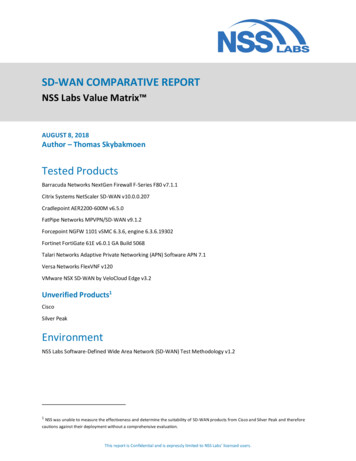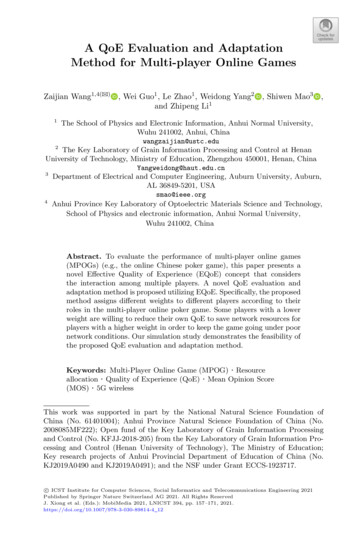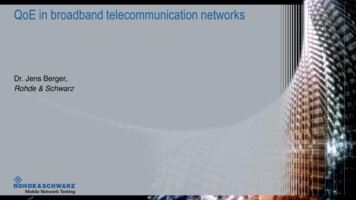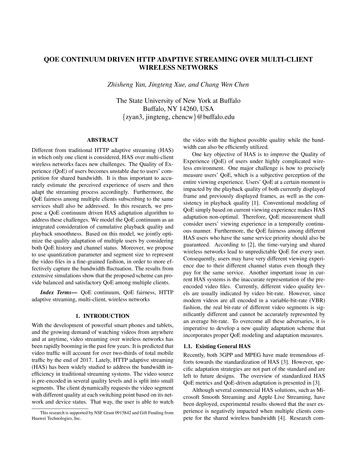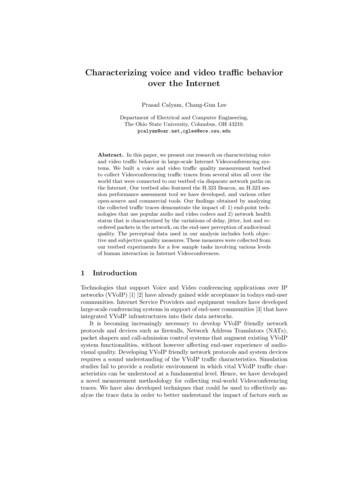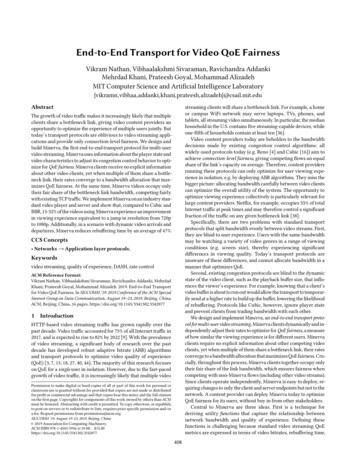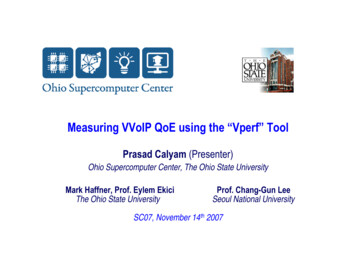
Transcription
Measuring VVoIP QoE using the “Vperf” ToolPrasad Calyam (Presenter)Ohio Supercomputer Center, The Ohio State UniversityMark Haffner, Prof. Eylem EkiciThe Ohio State UniversityProf. Chang-Gun LeeSeoul National UniversitySC07, November 14th 2007
Outline Background GAP-Model framework Vperf tool implementation of GAP-ModelPerformance evaluationMulti-Activity Packet Trains (MAPTs) methodology Voice and Video over IP (VVoIP) OverviewNetwork QoS and End-user QoE in VVoIPStreaming QoE versus Interaction QoEVperf tool implementation of MAPTsPerformance evaluationConcluding Remarks2
Voice and Video over IP (VVoIP) Overview Large-scale deployments of VVoIP are on the rise Video streaming (one-way voice and video) MySpace, Google Video, YouTube, IPTV, Video conferencing (two-way voice and video) Polycom, MSN Messenger, WebEx, Acrobat Connect, Challenges for large-scale VVoIP deployment Real-time or online monitoring of end-user Quality of Experience (QoE) Traditional network Quality of Service (QoS) monitoring not adequate Network QoS metrics: bandwidth, delay, jitter, loss Need objective techniques for automated network-wide monitoring Cannot rely on end-users to provide subjective rankings – expensive andtime consuming3
Network QoS and End-user QoE End-user QoE is mainly dependent on the combined impact of network factors Device factors such as voice/video codecs, peak video bit rate (a.k.a. dialing speed)also matterNetwork QoSEnd-user QoE Our study maps the network QoS to end-user QoE for a given set of commonlyused device factors H.263 video codec, G.711 voice codec, 256/384/768 Kbps dialing speeds4
Voice and Video Packet Streams Total packet size (tps) – sum of payload (ps), IP/UDP/RTPheader (40 bytes), and Ethernet header (14 bytes) Dialing speed isvoice codec; 64 Kbps fixed for G.711 Voice has fixed packet sizes (tpsvoice 534 bytes) Video packet sizes are dependent on alev in the content5
End-user QoE Types Streaming QoE End-user QoE affected just by voice and video impairments Video frame freezing Voice drop-outs Lack of lip sync between voice and video Interaction QoE End-user QoE also affected by additional interaction effort in a conversation “Can you repeat what you just said?” “This line is noisy, lets hang-up and reconnect ” QoE is measured using “Mean Opinion Score” (MOS) rankings6
Problem Summary Given: Video-on-demand (streaming) or Videoconferencing (interactive) Voice/video codec Dialing speed Develop: An objective technique that can estimate both streaming and interactive VVoIPQoE in terms of MOS rankings Real-time measurement without involving actual end-users, videosequences and VVoIP appliances An active measurement tool that can: (a) emulate VVoIP traffic on anetwork path, and (b) use the objective technique to produce VVoIP QoEmeasurementsVperf ToolNOTE: Vperf tool is a modified version of the Iperf tool; code extended fromVinay Chandrashekar’s (NCSU) implementation of VBR Iperf7
Existing Objective Techniques ITU-T E-Model is a success story for VoIP QoE estimation OSC’S H.323 Beacon tool has E-Model implementation It does not apply for VVoIP QoE estimation Designed for CBR voice traffic and handles only voice related impairments Does not address the VBR video traffic and impairments such as video frame freezing ITU-T J.144 (NTIA VQM tool) developed for VVoIP QoE estimation “PSNR-based MOS” – PSNR calculation requires original and reconstructed video frames forframe-by-frame comparisons Not suitable for online monitoring PSNR calculation is a time consuming and computationally intensive process Does not consider joint degradation of voice and video i.e., lack of lip synchronization8
GAP-Model Framework Earlier studies estimate QoE affected by QoS metrics in isolation E.g. impact due to only bandwidth/delay/loss/jitter We consider network health as a combination of different levels ofbandwidth, delay, jitter and loss – hence more realistic The levels are quantified by well-known “Good”, “Acceptable” and “Poor”(GAP) performance levels for QoS metrics Our strategy Derive “closed-form expressions” for modeling MOS using offline humansubject studies under different network health conditions Leverage the GAP-Model in Vperf tool for online QoE estimation for ameasured set of statistically stable network QoS metricsP. Calyam, M. Sridharan, W. Mandrawa, P. Schopis “Performance Measurement and Analysis of H.323 Traffic”,Passive and Active Measurement Workshop (PAM), Proceedings in Springer-Verlag LNCS, 2004.9
Vperf Tool Implementation of GAP-Model After test duration δt, a set of statistically stable network QoS measurements are obtained When input to GAP-Model, online VVoIP QoE estimates are instantly producedP. Calyam, E. Ekici, C. -G. Lee, M. Haffner, N. Howes, “A ‘GAP-Model’ based Framework for Online VVoIP QoEMeasurement”, In Second-round Review - Journal of Communications and Networks (JCN), 2007.10
GAP-Model Validation GAP-Model validation with ITU-T J.144 estimates (P-MOS) and network conditions nottested during model formulationP-MOS within the lowerand upper bounds11
MAPTs Methodology “Multi-Activity Packet Trains” (MAPTs) measureInteraction QoE in an automated manner They mimic participant interaction patterns and video activity levelsas affected by network fault events Given a session-agenda, excessive talking than normal due tounwanted participant interaction patterns impacts Interaction QoE “Unwanted Agenda-bandwidth” measurement and compare withbaseline (consumption during normal conditions) Higher values indicate poor interaction QoE and caution aboutpotential increase in Internet traffic congestion levels Measurements serve as an input for ISPs to improve networkperformance using suitable traffic engineering techniquesP. Calyam, M. Haffner, E. Ekici, C. -G. Lee, “Measuring Interaction QoE in Internet Videoconferencing”, IEEE/IFIPManagement of Multimedia and Mobile Networks and Services (MMNS), Proceedings in Springer-Verlag LNCS, 2007.12
MAPTs Methodology eorient’Type-I and Type-II fault detection13
Vperf Tool Implementation of MAPTs Per-second frequency of “Interim Test Report” generation Interaction QoE reported by Vperf tool - based on the progress of thesession-agenda14
MAPTs Measurements Evaluation Increased the number of Type-I and Type-II network fault events in acontrolled LAN testbed for a fixed session-agenda NISTnet network emulator for network fault generation Recorded Unwanted Agenda-Bandwidth and Unwanted Agenda-Timemeasured by Vperf tool(a) Impact of Type-I Network Fault Eventson Unwanted Agenda-Bandwidth(b) Impact of Type-I and Type-II NetworkFault Events on Unwanted Agenda-Time15
Thank you for your attention! Any Questions?16
Video alev Low alev Slow body movements and constant background; E.g. Claire video sequence High alev Rapid body movements and/or quick scene changes; E.g. Foreman video sequence ‘Listening’ versus ‘Talking’ Talking video alev(i.e., High) consumes more bandwidth than Listening video alev (i.e., Low)ClaireForeman17
Example – Session Agenda and Network Factor Limits File18
Traffic Model for MAPTs Emulation Traffic Model for probing packet trains obtained from trace-analysis Combine popularly used low and high alev video sequences and model them at256/384/768 Kbps dialing speeds for H.263 video codec Low – Grandma, Kelly, Claire, Mother/Daughter, Salesman High – Foreman, Car Phone, Tempete, Mobile, Park Run Modeling Video Encoding Rates (bsnd) time series Packet Size (tps) distribution Derived instantaneous inter-packet times (tps) by dividing instantaneouspacket sizes by video encoding rates19
An objective technique that can estimate both streaming and interactive VVoIP QoE in terms of MOS rankings Real-time measurement without involving actual end-users, video sequences and VVoIP appliances An active measurement tool that can: (a) emulate VVoIP traffic on a network path, and (b) use the objective technique to produce VVoIP QoE


